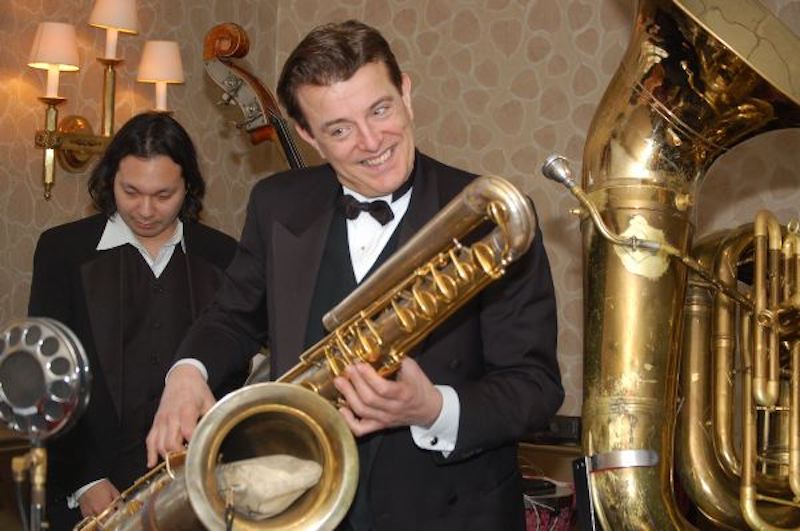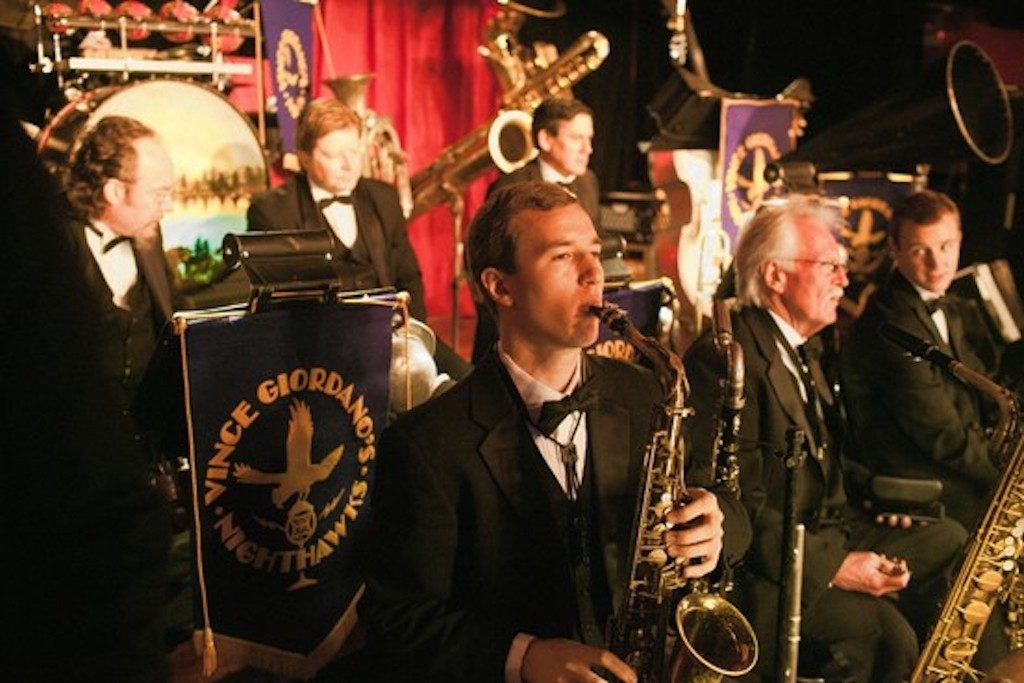by Marilyn Lester
Kudos to The Town Hall for a new family show series, Shoots and Scores, pairing classic silent film to live music – just as it was back in the day. This first outing of the series had the superlative Vince Giordano and the Nighthawks playing to a hilarious 1929 Laurel and Hardy silent, Double Whoopee, and to a full-length silent Buster Keaton masterpiece, 1928’s The Cameraman. The result of this dip into history was a tremendous amount of fun. To add to the enjoyment, Bill Irwin appeared as an entr’acte, a perfect living example of what made those long-ago actor-comedians so smart and funny.
Double Whoopie, a 20-minute short from Hal Roach studios, long the home of Stan Laurel and Oliver Hardy, showcases the duo at their funniest. The silence, it turns out is an asset: it allows the viewer to focus on the slapstick and sight gags without distraction. What was distraction, though, was the placement of the Nighthawks on stage relative to the movie screen. Lighting necessary for band members to see their scores intruded on a corner of the big screen, compromising the full intensity and clarity of the film. And because the band wasn’t in a pit, as show bands tend to be, the physical presence of the 11-member Nighthawks took some getting used to; the initial urge to look away from the screen toward the musical action was too much a temptation. It took adjustment to reconcile both compelling entities in close proximity.
For live stage action, the Nighthawks got to show their considerable stuff at the outset of the program, in the limelight with a swell, toe-tapping rendition of the jazz standard “Limehouse Blues” Philip Braham/Douglas Furber). Bill Irwin, actor, clown, vaudevillian, entertained in the truest sense of the word with song, dance and an impressive comedic sketch in between the screenings. Irwin’s multi-layered costuming and trunk full of props were pitch-perfectly in tune with the cleverness of the gags and his nonpareil timing. Irwin was, of course, accompanied with appropriate vaudevillian music by the Nighthawks.
The Cameraman is considered one of Buster Keaton’s masterworks. It spans 67 minutes over eight reels of film. It was considered lost until a print was discovered in 1968, then another, better one in 1991. Full of splendid sight gags and clever twists, the film is a wonder of Keaton’s physicality (he did his own stunts) and the ability of the star to remain stone-faced yet communicate a wealth of emotion. To this, Giordano and the Nighthawks played continuously and furiously – a real workout. The vintage jazz music was authentic. Some tunes were not readily recognizable (no matter), but some were, as in Duke Ellington’s haunting, “The Mooch,” to a comic scene in a swimming pool when Keaton loses his overly large swimsuit, and with “Side by Side” (Harry M. Woods) to a scene with Keaton vying for space with another swimmer in a closet-sized changing room.
Playing live to a film is a Herculean task for a full band and to complain may be splitting hairs. There were times when the music didn’t seem to match the action, and times when it was stunningly perfect, as with “Runnin’ Wild” in a comic running scene, and several piano and/or violin-only segments in tender moments. There were also instances when the enthusiasm of the band overpowered the screen action; yet it has to be noted that constantly changing tempos is a workout in itself. When all is said and done, Giordano is to be commended for his expertise and abilities in leading the Nighthawks in this nearly perfect effort. Playing out with “Good Old Days” (Dave Franklin ) the theme song from Hal Roach’s Rascals, was not only a clever bit of music selection, but a subtle hint – conscious or not – that creativity and art have the power to transcend time.
Shoots & Scores: Films In Concert, Vince Giordano & The Nighthawks, March 18, 2017, 3:00 pm at The Town Hall (123 West 43rd Street between Broadway and Sixth Avenue) www.thetownhall.org www.vincegiordance.com




















